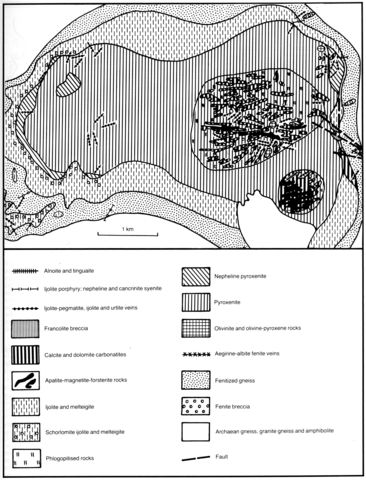stripes
This complex occurs within the gneisses and migmatites of the Belomorskaya Archaean series where the latter is associated with a Proterozoic sedimentary and volcanogenic sequence. The intrusion, the total area of which is about 20 km2, has an elliptical shape and a concentrically zoned structure, which is described in detail by Kapustin (1976). The central and largest part (12 km2) is composed of clinopyroxenites containing individual blocks and lenses of olivinite and olivine-pyroxene rocks. The peripheral zone is made up by melteigites and ijolites with schorlomite, and occasionally with K-feldspar. In the eastern part of the massif is situated a stockwork of phoscorites, which contain calcite and dolomite, that have been proved by drilling to extend to a depth of several hundred metres. In the eastern part of the outer contact zone of the complex are outcrops of breccias, which are similar to those of the Kovdozerskii complex, and probably produced by explosive eruption. The enclosing rocks are intensely fenitized. Four to six kilometres east of the complex in a zone of approximately east-west-trending fractures are outcrops of actinolite-calcite, dolomite-calcite, ankerite-calcite and siderite-dolomite carbonatites and quartz-carbonate rocks. Carbonatites are widely distributed through the complex, mainly as sheets and veins, but also as a stock-like body towards the eastern margin. They are spatially and genetically associated with magnetite-forsterite-apatite rocks (phoscorites), which form a series of thick bodies elongated in an east-west direction. Early and late carbonatites have been distinguished (Kapustin, 1976), the former comprising about 90% of the total. Carbonatite dykes of what is called an 'explosive facies' are described and illustrated with photomicrographs and numerous analyses by Lapin (1981). Veins and dykes are represented within the central complex by ijolite pegmatite, ijolite porphyry, monchiquite, nepheline and cancrinite syenites and tinguaite. Phoscorites are usually characterized by massive, spotted, lens-shaped banded structures and rarely by orbicular (liquation) structures with magnetite ovoids 0.5 cm in diameter, surrounded by a mesostasis of calcite-forsterite with apatite and phlogopite (Fizhenko, 1970; Landa, 1979). Some of these are illustrated by Lapin (1978) who considers the association of carbonatite and phoscoritic rocks in terms of immiscibility. Both apatite phoscorites and carbonatites contain a suite of rare earth and other accesssory minerals including baddeleyite, dysanalyte, pyrochlore, zirconolite, zircon, titanite and sulphides such as pyrrhotite and chalcopyrite. ÙSo/oo values for sulphides from melteigite vary from -1.0 to -2.2 and for calcite carbonatite from -3.8 to -4.3 (Grinenko et al., 1970).
FIZHENKO, V.V. 1970. On the genesis of orbicular texture in apatite-calcite-forsterite-magnetite ores of the Vuorijarvi and Gornozero massifs. In Petrological and structural analysis of crystalline formations. 167-73. Nauka, Leningrad.
GORBUNOV, G.I., BEL'KOV, I.V., MAKIEVSKY, S.I., GORYAINOV, P.M., SAKHAROV, A.S., YUDIN, B.A., ONOKHIN, F.M., GONCHAROV, Yu.V., ANTONYUK, E.S. and VESELOVSKY, N.N. 1981. Mineral deposits of the Kola Peninsula. Nauka, Leningrad. 272 pp.
GORKOVETZ, B.Ya., RAYEVSKAYA, M.B, BELOUSOV, E. and IRINA, K.A.. 1981. Geology and metallogeny of the Kostomuksha ore deposit region. 107-9. Petrozavodsk, Karelia. 143 pp.
GRINENKO, L.N., KONONOVA, V.A. and GRINENKO, V.A. 1970. Isotopic composition of sulphur of sulphides from carbonatites. Geokhimiya1: 66-75. Geochemistry International, 645-53.
*KAPUSTIN, Yu.L. 1976. Structure of the Vuoriyarvi carbonatite complex. International Geology Review 18: 1296-304.
KUKHARENKO, A.A., ORLOVA, M.P., BULAKH, A.G., BAGDASAROV, E.A., RIMSKAYA-KORSAKOVA, O.M., NEPHEDOV, E.I., IL'INSKII, G.A., SERGEEV, A.S. and ABAKUMOVA, N.B. 1965. The Caledonian complex of ultrabasic alkaline rocks and carbonatites of the Kola peninsula and north Karelia. Nedra, Moscow. 772 pp.
LANDA, E.A. 1979. On orbicular picrite of the Vuoriyarvi massif and genesis of similar rocks. Doklady Akademii Nauk SSSR, 245: 700-2.
*LAPIN, A.V. 1978. Geologic examples of limited miscibility in ore-silicate-carbonate melts. Doklady Earth Science Sections. American Geological Institute, 231: 163-6.
*LAPIN, A.V. 1981. Carbonatites and the explosive and dike facies (systematics of the geological facies of carbonatites). International Geology Review 23: 761-75.
ORLOVA, M.P. and DYADKINA, I.Yu. 1978. Regional and local varieties of the distribution of phlogopite deposits. Nedra, Leningrad. 85 pp.

